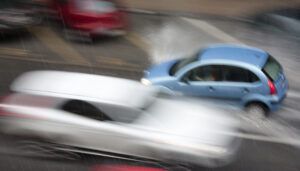Don’t Sidestep Your Sideswipe Collision


Don’t Let an Insurer Sidestep Liability for Your Sideswipe Collision. Contact Abeyta Nelson today.
Unlike rear-end collisions, sideswipe collisions and lane change collisions often present questions of who was at fault in the crash. In these cases, insurance companies often deny or lowball valid claims knowing that many unrepresented victims will not fight them. Even some attorneys will give up at the prospect of litigating a contested case. However, the attorneys at Abeyta Nelson Injury Law carefully investigate facts, apply the rules of the road, and navigate the court system to get fair and efficient compensation – even in the face of claim denials.
Because drivers expect the flow of traffic to generally move forward in the lanes of travel, any move side-to-side such as turning and changing lanes presents a risk. When first getting our driver’s licenses, we learned the “rules of the road.” These same traffic rules guide courts in deciding who is at fault in sideswipe collisions.
For instance, while sometimes it is safe to pass in an oncoming lane, specific rules prohibit passing within 100 feet of intersections because it is dangerous. A driver turning left at that intersection doesn’t expect a vehicle passing at that location. Lane markings, such as a solid, double yellow line, show where lane crossing movement is prohibited.
Common Challenges with Insurance Claims After a Sideswipe Accident
Even where turning or changing lanes is allowed, drivers must use their turn signal and check their mirrors immediately before moving left or right from their lane. A driver who attempts an illegal pass, fails to use a turn signal or fails to check their mirror may be found at fault for a crash. Even if the other driver violated the rules, insurers will often argue that you also violated the rules and should only recover a fraction of your damages.
Exactly where and how a crash occurred is essential to establishing who was at fault. Hiring an attorney soon after an accident will help obtain key evidence such as police investigations, video camera images, photographs of vehicles, debris and fluids, witness statements, and comprehensive vehicle inspections. Physical evidence is crucial when the parties’ recollection of the crash conflicts. Even if the other driver admits fault and apologizes right away, their story can change after talking with their insurance company or lawyer.
Carefully marshaling evidence and presenting the relevant legal authority to the insurance company often results in fair settlements. However, when the insurer digs in its heels, you will want an attorney who is ready and willing to litigate your case in the appropriate venue. Unfortunately, some west side and out-of-state attorneys will take an Eastern Washington case only to drop it when they need to actually file the case here. This leaves the victim high and dry, owing money for treatment, missing wages from time off work, and uncompensated for their pain and suffering.
Navigating Insurance Claims and Litigation with Yakima Car Accident Lawyers
Luckily for our clients, Abeyta Nelson Injury Law has been aggressively litigating cases in Central Washington for decades. Whether the case involves catastrophic injuries and death, or less serious injuries, proving fault is necessary to fair compensation. Abeyta Nelson lawyers tailor a litigation strategy to the needs of each client and the scale of each case. That can make the difference between a claim denial from the insurance company to a fair award that pays the bills and compensates you for your injuries. Contact our law firm today to set up a free consultation about your car accident case.
-blog written by attorney James M. Boyer, Abeyta Nelson Injury Law